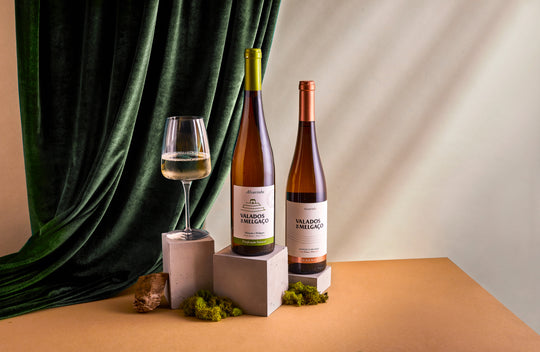EXPERIENCES
"Experiences" are curated, personalized wine-tasting + dining events that connect guests with sommeliers, wineries, or restaurants, offering memorable and tailored interactions around wine culture.
Bertil Tøttenborg - Bolivian Wine Expert
Sommelier at renowned GUSTU Restaurant teaches us everything we should know about magnificent Bolivian wines
VIEW RECORDED CLASS BELOW:
The undiscovered Bolivian wine world, a SommClass by wine and spirits expert and beverage director of Gustu Restaurant, Bertil Tøttenborg. First, what is Gustu? Its a quechua word for flavour, and a restaurant and bar placed in La Paz, Bolivia, which opened in April 2012. Gustu is under the management of Head Chef Marsia Taha. It is considered among South America's 50 best restaurants, landing the number 32 spot on The Latin America’s 50 Best Restaurants 2014 and the number 14 spot in 2017. Until very recently I had no idea that Bolivia was a wine-producing country; too close to the equator and therefore surely too hot I assumed! Then, over Easter this year, I had the amazing opportunity to visit its different wine regions – and I was seriously surprised at this little known country’s exciting wines!
Why should we take any interest in far-off Bolivia?
For a start, Bolivia is the only wine region in the world where you can visit a good quality vineyard in the morning and a coffee plantation in the afternoon! The country has 4 wine regions, and its most northerly – Samaipata – is not only on the border of the Amazon rainforest, but also on the very edge of cool climate seasonality. Any further north than this and the climate becomes tropical, with temperatures too warm all year round to grow grapes, whereas coffee beans thrive. Bolivia has some of the highest altitude vineyards in the world! Her biggest and best wine region, the “Central Valley”, lies in the “foothills” of the Andes around the town of Tarija in the south of the country, at altitudes between 1600 – 2250mts. Only Salta, roughly 300kms south and just across the border into Argentina, has higher vineyards than this anywhere else in the world. These high altitude vineyards are essential at this latitude – Tarija lies just south of the Tropic of Capricorn – because the nights are cool and daytime temperatures rarely rise above 35C. They produce red wines with powerful aromatics and immense fruit concentration, combined with a welcoming freshness.
Why should we take any interest in far-off Bolivia?
For a start, Bolivia is the only wine region in the world where you can visit a good quality vineyard in the morning and a coffee plantation in the afternoon! The country has 4 wine regions, and its most northerly – Samaipata – is not only on the border of the Amazon rainforest, but also on the very edge of cool climate seasonality. Any further north than this and the climate becomes tropical, with temperatures too warm all year round to grow grapes, whereas coffee beans thrive. Bolivia has some of the highest altitude vineyards in the world! Her biggest and best wine region, the “Central Valley”, lies in the “foothills” of the Andes around the town of Tarija in the south of the country, at altitudes between 1600 – 2250mts. Only Salta, roughly 300kms south and just across the border into Argentina, has higher vineyards than this anywhere else in the world. These high altitude vineyards are essential at this latitude – Tarija lies just south of the Tropic of Capricorn – because the nights are cool and daytime temperatures rarely rise above 35C. They produce red wines with powerful aromatics and immense fruit concentration, combined with a welcoming freshness.
Attend SommClass with Bertil Tøttenborgfrom GUSTU LA PAZ
What's This Class About?
What is Bolivian wine and why is it so different.
Bolivia’s wine culture.
How do Bolivians appreciate wine?
The various types of Bolivian wine style
A Bolivian wine producer’s work motivation and passion.
Indigenous Grape varietals of Bolivia
What you’ll typically find, what works and what doesn’t work in Bolivia’s wine region
Bolivian wine signatures – from classicist to modernist
How far can Bolivia reach as a wine producing country?
Why take this SommClass?
WHERE IS THE BOLIVIAN WINE REGION?
Bolivia's wine industry is based in the southern city of Tarija, near the southern border with Argentina. This region has long produced small amounts of artisanal wine, as well as the distilled grape-based spirit known as singani, the national drink. ... Bolivian wine is exotic. We are a high-altitude wine.
HEIGHT OF THE VINEYARDS (METERS)
1,600 to 3,000 100% of the vineyards are at high altitude
HECTARES OF VINEYARDS
3,000 100% harvested by hand
NUMBER OF WINERIES
65 Producing wines of altitude
GRAN PATRONO
The first Marselan wine produced in Bolivia With the name of “GRAN PATRONO” the first Marselan variety wine produced in Bolivia is launched to the national market. The Marselan strain is used for the production of high-end red wines.
WHAT IS GUSTO RESTAURANT ?
One of the worlds 50 best restaurants. Gustu, the quechua word for flavour, is a restaurant and bar placed in La Paz, Bolivia, which opened in April 2012. Gustu is under the management of Head Chef Marsia Taha.
Your host
BERTIL TØTTENBORG
Born and raised in Copenhagen, Denmark, Bertil Tøttenborg is a certified Sommelier by the Copenhagen Wine Academy. He discovered his passion for food as a child, when he learned to enjoy different ingredients and cooking styles with his family, while helping his parents prepare family meals.
As he grew older, he understood that his true calling was in the service area, especially in relation to wine and beverages, so he focused his studies and work experience working in prestigious Danish restaurants, reaching the position of Head Sommelier.
In 2015, he joined the Gustu family, where he has developed an in-depth knowledge of wines, spirits, crafted beers and coffees, produced in the country, guiding Gustu’s offer towards prioritizing the work of small producers and supporting the production of organic and biodynamic wines.
Mónica Marín
Meet Mónica Marín, head instructor for the Wine and Spirits Education Trust (WSET) https://www.wsetglobal.com
Originally from Spain, Monica Marin currently serves as Director of Education at The Wine House, named one of the world’s best wine shops by Food & Wine magazine. She is also a head instructor for the Wine and Spirits Education Trust (WSET), teaching foundational, intermediate, advance, and diploma levels in the U.S. and Latin America. This year, Monica was recognized by WSET with the Educator of the Year Award – she was the only Latin female nominee among 10 candidates worldwide.
Mastering the art of tasting is essential in order to get the most out of your wine drinking. The important thing to remember is that anyone can be a good taster, as long as they have an unimpaired sense of smell and taste, and are prepared to concentrate. The ideal conditions for tasting are easy – a quiet room and good lighting. The glasses should, of course, be clean, and of the correct
shape to allow you to indulge fully in both the aroma and taste of the wines.
La clase de una hora, va a consistir en una entretenida sesion de cata, donde voy a mostrarles la mejor tecnica de degustacion de vinos mediante
la aplicacion de una degustacion sensorial a traves de la vista ( analisis de la apariencia del vino ), a traves del olfato ( analisis de los aromas ) y finalmente el analisis de los sabores utilizando nuestro paladar. No se pierdan esta amena clase de 60 minutos donde acabaran degustando vinos como verdaderos
profesionales ! Despues de esta clase , podran degustar vinos de Burdeos, Rioja, Borgoña o Barolo , como lo hacen los Sommeliers de verdad !
Monica Marin, Diploma WSET/Best Educator wine Scholar Guild 2019/Nominated Best Educator WSET 20
Join us for an exclusive French Bordeaux wine tasting experience with renowned author Gabrielle Macey as she discusses her bestselling novel "Garago" Set in the elegant Pasjoli Restaurant, this event promises an evening of captivating conversation, fine wines, and a unique gastronomic journey.
Location: Pasjoli Restaurant
2732 Main St., Santa Monica, CA 90405, USA
Date: NOV 18th
Time: 4PM
Cuisine: Appetizers - French, Contemporary
Wines Presented by: Sommtable Imports
Can't make it in person?
The entire event will be live-streamed for those who want to join from anywhere in the world!
This is a must-attend experience for literature enthusiasts and wine lovers alike!
This experience is a lecture on chocolate given by Alejandro Campos, a Master Chocolatier and co-owner of Wolter Chocolate in Tabasco, Mexico.
The Olmecs, one of the earliest Latin American civilizations, were the first to make chocolate from the cacao plant, using it in ceremonial drinks. Later, the Mayans revered chocolate as the food of the gods, even burying dignitaries with bowls of it. They made a thick, frothy drink called xocolatl, meaning "bitter water." The Aztecs, who believed chocolate was a gift from the god Quetzalcoatl, used cocoa beans as currency and consumed chocolate as a refreshing beverage, aphrodisiac, and war preparation. They also used dark chocolate medicinally to treat ailments like headaches and heart issues. In 1528, Spanish explorer Hernán Cortés introduced the chocolate drink to Spain, where sugar was added to enhance its flavor.
Introduction
- Chocolate has similarities to wine, including polyphenols, antioxidants, flavonols, sugars, and fermentation process.
- Alejandro Campos is introduced as an influential voice in the chocolate industry and a judge for international chocolate awards.
Chocolate Production Process
- Cacao pods grow on tree trunks and contain beans covered in sweet and sour pulp.
- The beans are fermented for 48 hours, then dried in the sun for about four days.
- Roasted beans are processed into cacao nibs, then ground into cacao paste or liquid.
- Cacao paste can be pressed to separate cocoa butter and cocoa powder.
Types of Chocolate
- Look out for Commercial chocolates: Many ingredients, often with chemical additives.
- Good chocolates: 7-10 ingredients, including cacao paste, sugar, and cocoa butter.
- Fine chocolates: Made ONLY with cacao paste, cocoa butter, and some sugar.
Bean-to-Bar and Tree-to-Bar Concepts
- Bean-to-bar: Chocolates made from dried cacao beans.
- Tree-to-bar: Process that includes caring for cacao trees, fermentation, and drying.
Chocolate Refinement
-
Explains the importance of particle size in chocolate:
- 400-500 microns: Initial grinding
- 200 microns: Mexican-style chocolate
- 100 microns: Thick European-style chocolate
- 20-25 microns: Fine, creamy chocolate
- Discusses the issue of chocolate bloom, where cocoa butter separates from other ingredients, affecting appearance and texture.
The experience provides a comprehensive overview of chocolate production, types, and quality factors, emphasizing the importance of understanding these aspects to appreciate fine chocolate.
An enchanting Valentine's Dinner experience with our "7 Regions Epicurean Adventure." Immerse yourself in a romantic journey as you and your loved one savor exquisite flavors meticulously curated from seven distinct regions. From the rich aromas of carefully selected wines to the exquisite dishes that celebrate love through every bite, this culinary expedition is designed to create lasting memories. Elevate your Valentine's Dinner celebration with a unique blend of passion, culinary craftsmanship, and the joy of shared moments. Join us for a night of love, laughter, and gastronomic delight.
HOST
Monica Marin, DipWSET - Director of Wine Education
MENU
O'dourves
2018 Cuvage Rose Brut, Nebbiolo D’Alba DOC
First Course:
Caviar Tuna Tartare
NV Nominé-Renard Brut Champagne
Second Course:
Hummus Topped w/ Pistachio served w/ fresh sourdough bread
2022 Dr K. Frank Dry Riesling, Finger lakes, NY
Third Course:
Salmon, Potato purée, Saffron Cranberry Sauce
2020 The Ned Pinot Noir, Marlborough or 2022 coelho estate white pinot noir
Adega Mayor Seleção Branco
Fourth Course:
Filet Mignon Steak, baby Potatoes
2004 Urbina Rioja Gran Reserva
Fifth Course Desert:
Rose: Vanilla Mousse, Pistachio and Strawberry insert
NV Santo, Moscato D’ Asti DOCG , Piemonte
Sixth Course Desert:
Saint Honore: Puff pastry filled w/ Madagascar vanilla topped w/ 24h infused Madagascar Ganache
2011 Il Grigio in Pincis , Vin Santo del Chianti Classico DOC
Seventh Course Desert:
Valentino: Dark chocolate mousse, raspberry insert, coconut sponge
NV La Quinta Syrah Port, Paso Robles
STARTS AT:
FEB. 14th 2023 - 7:30 PM
ADDRESS:
the New AVA KRO BEL AIR (private)
2337 Roscomare Rd Los Angeles, CA 90077
https://maps.app.goo.gl/kj5SG8NvhQggWVEDA
Simon Kistenfeger
Somm Simon Kistenfeger explains the importance of the most basic element in our life and why it's so important.
Juan Pablo Villota - Colombian Coffee Expert
Juan Pablo Villota believes colombian coffee should be treated like a great wine. Its terroir, its flavours, its aromas — all of these things should be considered and appreciated.
What's This Class About?
- The origin , and product proposal as a key factor to produce and enjoy a high end single origin Colombia coffee
- Short introduction to Café de Colombia as a origin
- Characteristics, Regions, Structure
- Brief explanation of the coffee plantation and transformation of the coffee fruit
- Harvesting, post harvest, dry mill and roasting
- The importance of sorting the coffee fruits
- Five Step Selection Process
- How to brew a great cup of coffee
- Extraction forces, coffee ratio and particle size
- Recipes using V60 ( gravity force ) and Coffee Press ( immersion )
- Learning to identify and to enjoy a specialty coffee cup
- Origin, labelling, family,
- Senses: Visual, Nose ( fragrance, aroma ) and Palate
- Flavor and Aftertaste
*(If attendees want to brew their coffee brand and share their cup comments are more than welcome)
Why take this SommClass?
THE STORY
In 1972 Mr. Gustavo Leyva acquired the Alsacia farm in Buenavista Quindío, a longtime dream for him. Nevertheless, joy came at a difficult moment. His youngest son Alberto died on an airplane accident. To honor his son, the farm was named San Alberto. Since then, San Alberto estate has become an iconic farm of the region due to its rigorous agricultural practices. Three generations later, Juan Pablo and Gustavo Villota Leyva (grandsons of Mr. Gustavo), have transformed San Alberto coffee to Colombia’s most award-winning coffee. The key for success has been the commitment towards flavor and a fierce protection of the natural and social conditions surrounding the farm. San Alberto is the largest employer of the little town of Buenavista, hiring men and single mothers. Discipline made them obtain two important sustainable agriculture stamps, Rain Forest Alliance and UTZ.
A BLESSED SOIL
San Alberto coffee is grown exclusively at San Alberto estate. Its flavor is intimately linked with this blessed terroir full of nutrients, rich in water springs. With a special microclimate that provides a characteristic flavor with a unique identity. The farm lies in Buenavista in Quindío, the smallest town of Colombia’s smallest state (Quindío), amidst the Colombian coffee belt. Confluence of irreplaceable weather conditions: warm winds from the Quindío Valley and cold air from the Central Mountain Range sculp this land. As a result drastic daily temperature variations occur: 12- 30ºC
SAN ALBERTO COFFEE
San Alberto’s flavor is intimately linked with the Colombia San Alberto estate, a blessed soil that provides a very characteristic flavor with unique identity.
FLAVOR OF SAN ALBERTO
A coffee with luscious, sweet aromatic notes, reminiscent of caramel and mellow dark chocolate, notable for its delicate fruit-like acidity and harmonious balance, which yields a distinctive and elegant carácter on the palate.
COFFEE TEMPLES
Open in Terraza San Alberto, Usaquén, Cartagena and Museo del Oro, with unique experiences offered at each location.
AWARDS OF SAN ALBERTO
Among the many awards Hacienda San Alberto has won from the International Taste and Quality Institute in Brussels are Three Gold Stars in 2012, as well as six consecutive Gold Awards from the Monde Selection (2104-2019), and the National Federation of Coffee Growers “Colombia, Land of Diversity” prize, given to the farm in 2017 for excellence in quality and social entrepreneurship.
A DEPURATED TECHNIQUE
Behind San Alberto´s flavors, there is a depurated technique which acknowledges that taking good care of a magical flavor is a big responsibility. Rigor plus artistic craftsmanship are key in every step. A signature process, The Five Step Selection, guarantees that only the best beans of the farm end up reaching the market. But it´s Juan Pablo Villota, the master coffee cupper, who artistically blends the flavors of the varietals cultivated at the estate, and creates a whimsical new flavor. On average no more than 60% of the farms production become San Alberto coffee.
About Juan
Expert Juan Pablo Villota Leyva is taking full advantage of these ideal conditions to push Arabica beans to new heights, winning more awards than any other coffee grower in Colombia with his Café San Alberto.
You might say that Villota Leyva has coffee running through his veins after having been born in a coffee growing family.
He operates Hacienda San Alberto, perched on a steep ravine of the Central Cordillera of Quindio state. San Alberto was founded when Villota Leyva’s grandfather Gustavo Leyva, defied local customs and planted his Arabica coffee trees 5,900 feet above sea level. His father, Eduardo Villota, would continue the family planting tradition before Juan Pablo would take over.
He combined his father’s and grandfather’s farming knowledge with an international degree from the University of Toronto’s Rotman School of Management to develop a premium global brand with his Arabica Caturra, Arabica Castillo and Arabica Gesha.
Read MORE About Mr. Villota here> https://www.sommtable.com/the-arabica-whisperer






















